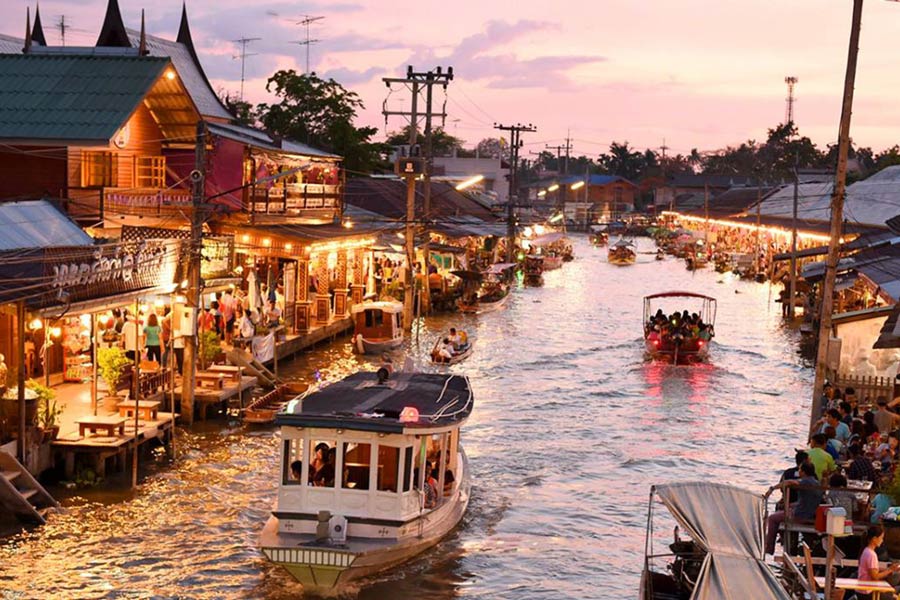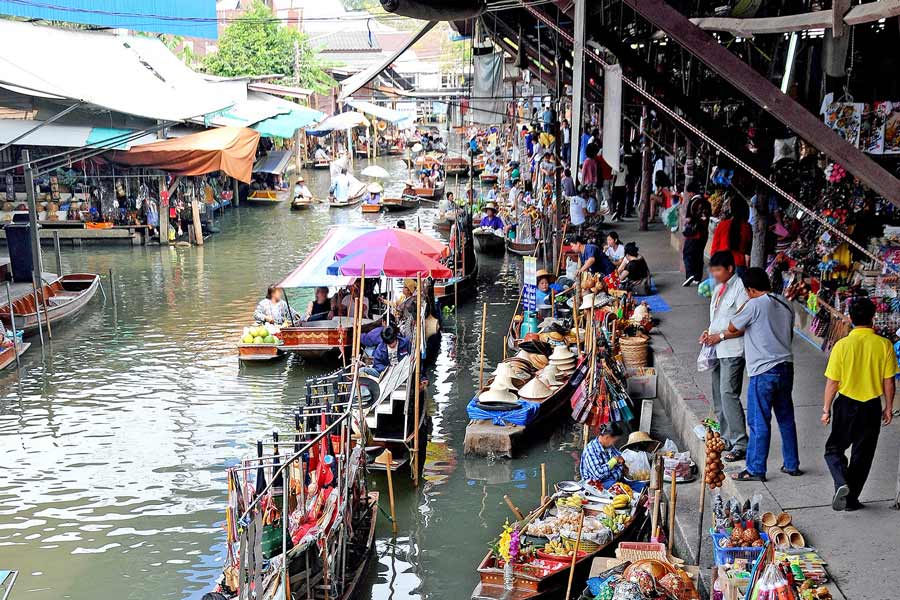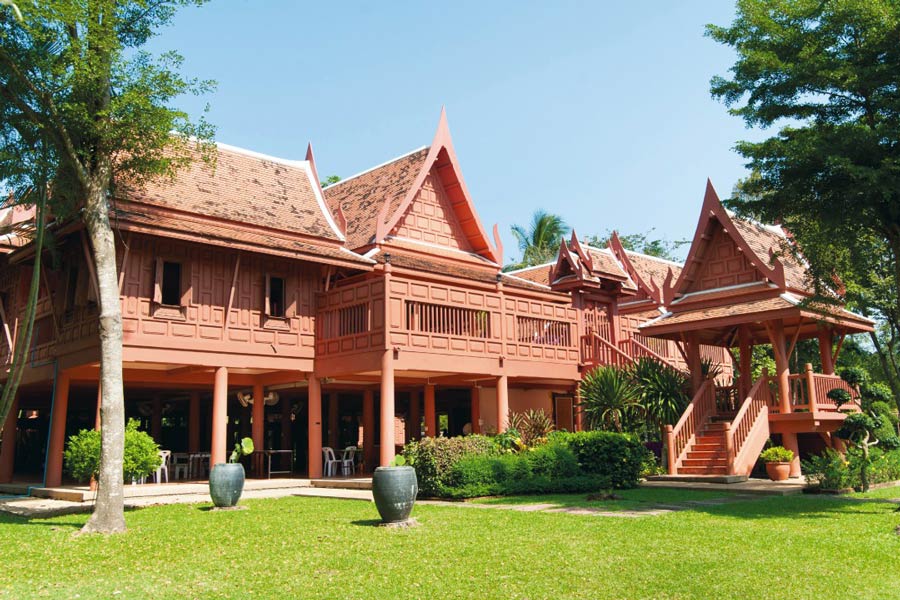South of Bangkok's bustling energy lies a hidden gem - Samut Songkhram. This charming coastal province offers a breath of fresh air. Think pristine beaches, ancient temples, and a laid-back vibe that washes away your worries. Dive into the vibrant Amphawa Floating Market, a feast for the senses. Explore the unique Wat Bang Kung temple, built right into a tree! Foodies will love the fresh seafood and local flavors. Samut Songkhram promises a relaxing escape, perfect for those seeking a slower pace and a taste of Thailand's rich history.

Samut Songkhram
History of Samut Songkhram
Samut Songkhram's past whispers of maritime trade and ancient empires. During the Ayutthaya Kingdom (1350-1767), the area flourished as a vital port, exporting rice and other goods across the seas. Evidence of this era can still be found in museums and historical sites scattered throughout the region. The town itself, originally called Suan Nok ("outer garden"), was established around this time and served as an administrative center.
Fast forward to the reign of King Taksin the Great (1767-1782), and Samut Songkhram gained official provincial status. It also became the birthplace of Queen Amarindra, wife of King Rama I, who is credited with initiating the name Suan Nok. The province continued to hold strategic importance throughout Siamese history, due to its location at the mouth of the Mae Klong River.
Attraction of Samut Songkhram
Places to Visit in Samut Songkhram
- Amphawa Floating Market: Immerse yourself in the vibrant colors and aromas of this iconic floating market. Sample local delicacies, shop for souvenirs, and experience the unique charm of this traditional market.

Amphawa Floating Market
- Damnoen Saduak Floating Market: Explore this bustling floating market, known for its colorful boats and lively atmosphere. Enjoy a boat ride, bargain for fresh produce and handicrafts, and savor delicious Thai cuisine.

Damnoen Saduak Floating Market
- King Rama II Memorial Park: Pay your respects at this park dedicated to King Rama II, who was born in Samut Songkhram. Explore the park's gardens, ponds, and pavilions, and learn about the life of this revered Thai monarch.

King Rama II Memorial Park
- Wat Bang Kung: Discover this unique temple, built inside a tree trunk. Admire the intricate carvings and statues, and marvel at this architectural masterpiece.

Wat Bang Kung
Food
Samut Songkhram's cuisine is a delightful blend of fresh seafood, local produce, and traditional Thai flavors.
- Pla Muek Khai Dam (Grilled Squid with Salted Egg): This dish is a local favorite, made with fresh squid grilled to perfection and topped with a savory salted egg sauce.
- Khao Chae (Wet Rice): This refreshing dish is perfect for a hot day, made with jasmine rice soaked in fragrant pandan water and served with various toppings like shrimp floss, shredded chicken, and fried shallots.
- Hoi Thapthim (Deep-Fried Mussels): These crispy and flavorful mussels are a popular snack or appetizer, coated in a batter seasoned with turmeric and garlic.
- Gaeng Som Pla Chon (Sour Soup with Fish): This tangy and aromatic soup is made with fresh fish, tomatoes, and a variety of herbs and spices.
- Khanom Krok (Thai Coconut Pancakes): These bite-sized pancakes are made with a batter of coconut milk, rice flour, and sugar, and cooked in a special mold to create their distinctive shape.

Pla Muek Khai Dam
Traveling Cost of Samut Songkhram
The cost of traveling to Samut Songkhram varies depending on your budget and travel style.
Accommodation:
- Budget guesthouses: $5-10/night
- Mid-range hotels: $20-50/night
- Luxury resorts: $100+/night
Food:
- Street food: $1-3/meal
- Local restaurants: $5-10/meal
- Tourist restaurants: $15-20+/meal
Transportation:
- Public buses: $1-2/ride
- Taxis: $10-20/trip
- Motorbike rentals: $5-10/day
Best Time to Visit Samut Songkhram
Samut Songkhram offers a delightful experience year-round, but to truly maximize your enjoyment, consider these factors:
- Pleasant weather: The cool season (November - February) reigns supreme. Expect sunshine, comfortable temperatures, and clear skies, ideal for exploring and outdoor activities.
- Fewer crowds: The shoulder season (March & October) offers decent weather with a slight dip in tourist numbers. It can be a good choice if you prefer a quieter experience.
- Festivals and events: April welcomes the vibrant Songkran water festival, a joyous celebration of the Thai New Year. November features the Samut Songkhram Seafood Festival, a haven for seafood enthusiasts.

Best Time to Visit Samut Songkhram
How to Get To Samut Songkhram
Samut Songkhram boasts excellent accessibility from Bangkok:
- By Bus: Numerous comfortable and affordable buses depart from Bangkok's southern bus terminals (Sai Tai Mai or Ekkamai) throughout the day. The journey takes approximately 1-2 hours.
- By Train: Several daily trains connect Bangkok's Hua Lamphong Station to Mahachai station in Samut Songkhram. The train ride is a scenic option, taking roughly 2-3 hours.
- By Car: If you prefer the freedom of a road trip, driving from Bangkok takes about 1-2 hours depending on traffic. Several car rental companies operate in Bangkok, offering various vehicle options.
Explore Samut Songkhram with Asia King Travel
Samut Songkhram whispers promises of a captivating escape. Pristine beaches beckon sun-seekers, ancient temples resonate with whispers of the past, and the vibrant Amphawa Floating Market ignites your senses with a kaleidoscope of colors and flavors.
Ready to embark on an unforgettable journey to Samut Songkhram? Contact Asia King Travel today and let us craft your dream Samut Songkhram adventure







